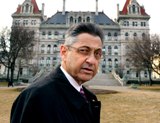 Assembly Speaker Sheldon Silver said late last night that New York’s Legislature has agreed to a 2009-10 state budget that will keep school funding flat, restore aid to New York City, and includes increased income tax rates for wealthier New Yorkers. The agreement announced just before midnight also includes some restoration of proposed cuts in health care and in higher education and includes a bigger bottle law, putting nickel deposits on bottled water under the measure that currently covers only carbonated drinks.The powerful Manhattan Democrat tells The Associated Press that the spending plan will likely be adopted Tuesday, resulting in an on-time budget.
Assembly Speaker Sheldon Silver said late last night that New York’s Legislature has agreed to a 2009-10 state budget that will keep school funding flat, restore aid to New York City, and includes increased income tax rates for wealthier New Yorkers. The agreement announced just before midnight also includes some restoration of proposed cuts in health care and in higher education and includes a bigger bottle law, putting nickel deposits on bottled water under the measure that currently covers only carbonated drinks.The powerful Manhattan Democrat tells The Associated Press that the spending plan will likely be adopted Tuesday, resulting in an on-time budget.
There is no total yet for the budget but it will include $5 billion in spending cuts and use $5 billion of the federal economic stimulus package to help fill some of the gaps created by rejecting increases in some other taxes and fees.
The temporary income tax increase is projected to provide the state $4 billion in revenue and will end after three years, Silver said.
The deal will add two more tax rates over the current highest rate of 6.85 percent. New Yorkers making more than $300,000 but less than $500,000 would face an income tax rate of 7.85 percent. New Yorkers making more than $500,000 would see a rate of 8.97 percent.
The measure is a compromise of one first pushed by labor unions representing health care workers, teachers and other public employees to avoid cuts to their funding. Proposals on the table last week included a permanent tax rate increase, an increase in the tax rate for all making more than $250,000 a year, and a higher rate still for those making more than $1 million a year.
“all the bills are printed, some are on the (legislators’) desks already, some will be put on the desks momentarily,” Silver said in an interview. “I would say, yes, we have a final agreement.”
The bills will “age” the required period of time for lawmakers and the public to view them and should be voted on by the end of Tuesday, making the April 1 deadline for the first time in three years.
“This is a very difficult budget that reflects the extraordinary challenges we face,” Silver said, noting the budget gap was estimated at $16.5 billion.
Among the few new programs is a $50 million fund to provide low-interest college loans to middle class and lower income families. The idea was first proposed in Paterson’s budget presented in December.
Among the other elements of the deal to be made public Sunday are:
Flat school aid. Paterson had proposed a 3.3 percent cut in school aid, or about $698 million, but that was filled under the federal economic stimulus plan that required some of New York’s two-year package to fill any cuts to education. However, public schools were expecting to see as much as a $2.5 billion more this year. The projected aid is part of a 2007 law forced by a court ruling that the state failed for decades to fulfill its constitutional duty to adequately fund schools. Silver says schools will get a total of $1.1 billion more in aid than proposed by Paterson.
The state’s powerful teachers unions and the superintendents’ lobby say failure to provided the money that was expected could trigger as many as 8,000 layoffs. The last time schools received less than expected, a half-decade ago, school districts increased local property taxes instead by an average of 10 percent. New Yorkers already pay some of the nation’s highest property taxes.
Reversing some of the “damaging cuts” in health care, that had hospital advocates warning that hospitals would be closed if Paterson’s proposal wasn’t amended.
Adding water to the state’s bottle redemption law, which should bring in $118 million in revenue to the state.
$125 million more to the State University of New York, for a total of $2.5 billion; and $86 million more to the City University of New York to a new total of $1.4 billion in funding.
Rejects proposals for gas tax and another that would have allowed wine to be sold in supermarkets.
Paterson warns that he expects the deficit to grow by another $3 billion by the end of that fiscal year because forecasts continue to declining tax revenues.
The current budget totals about $120 billion with all state and federal funds.
In mid-December, a month early, Paterson proposed a $121 billion budget to the Legislature that increased overall spending just 1.1 percent the smallest percentage of growth since Republican Gov. George Pataki’s budget proposal for the 1996-97 fiscal year.
Paterson was trying to reverse years of overspending that produced year-end deficits even in flush years. He was also reacting to the meltdown on Wall Street, on which the state has traditionally depended for 20 percent of its revenues.
Silver said the deal will cut by more than half the $7 billion in taxes and fees that were proposed, even as taxing in time of a recession was blasted Friday by the state Business Council.
“It is impossible to view the emerging budget as a path to economic recovery,” council President Kenneth Adams said Friday before the final deal was struck. “This course will doom New York to lag the rest of the nation when the recovery begins.”
Billionaire entrepreneur and philanthropist B. Thomas Golisano sought to derail reports of high spending and high taxing in a visit to the Capitol last week, blaming the Legislature for spending at two and three times inflation even in good fiscal years.
“The state was in trouble long before the recession,” Golisano said. “The recession only exacerbated it.”
{WCBS-HD/Matzav.com Newscenter}











